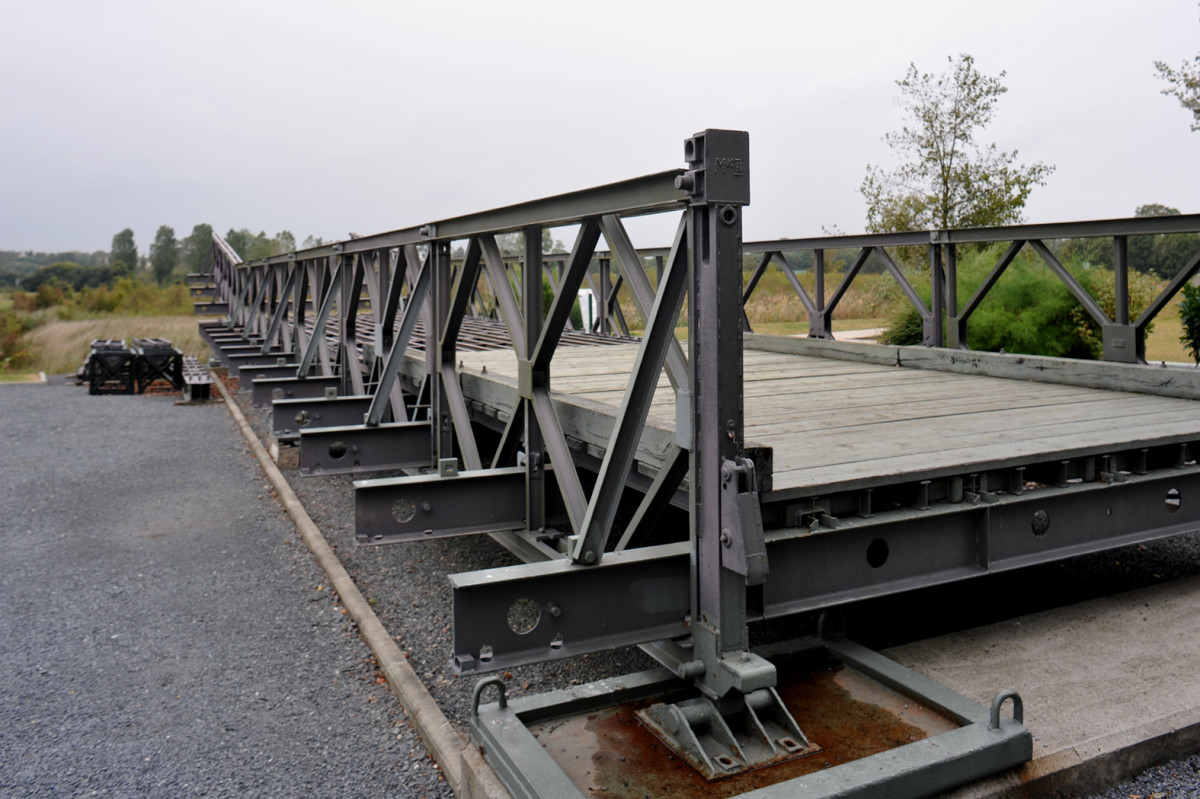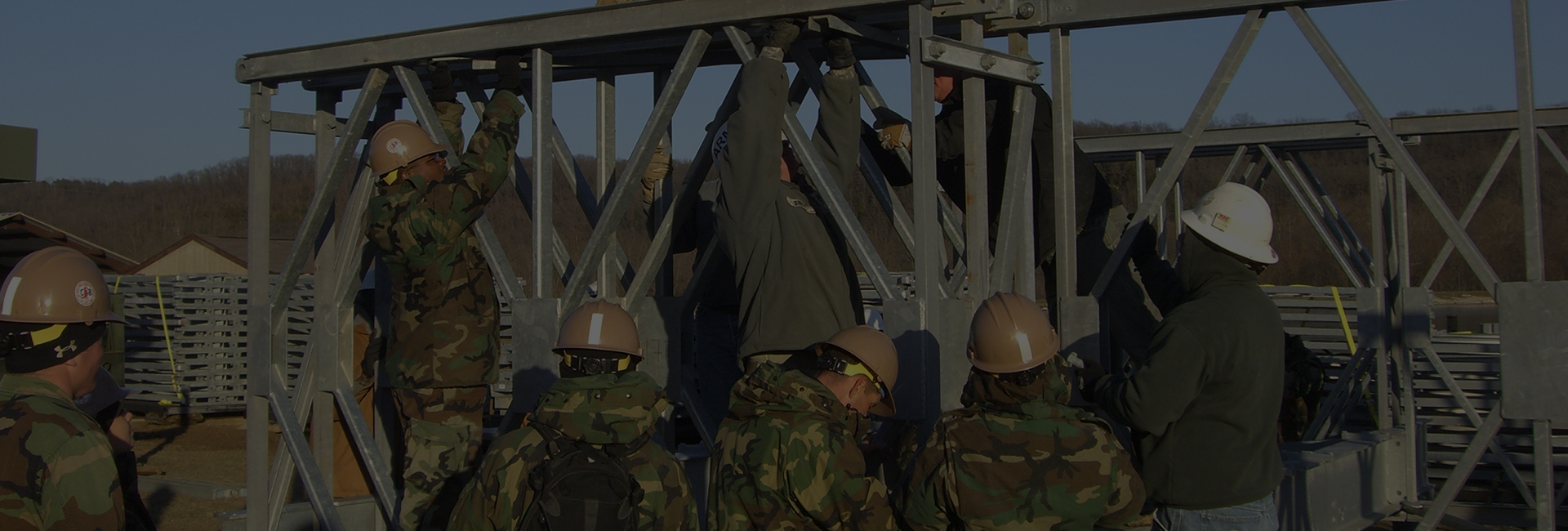Military Temporary Bridge - Land bridges provide critical infrastructure for military logistics support programs, humanitarian assistance, and disaster relief. Capable of supporting heavy vehicles in a variety of conditions, bridges are ideal for meeting time-sensitive, critical infrastructure needs.
Line of communication (LOC) dry bridges provide critical logistical support in a variety of challenging environments. Military Load Class (MLC) Designed to accommodate large armored tanks and other heavy vehicles carrying loads up to 120T / 150W, our modular steel components are easily transported and require no temporary or permanent bridging. will be reused. Our heavy-duty ramps, railings and other special equipment facilitate immediate reliable connection when existing infrastructure is weakened or destroyed.
Military Temporary Bridge

Dry gap reduction solutions are used by military organizations and humanitarian agencies around the world. With training programs tailored to your operational goals and comprehensive service - from planning to implementation - you can quickly deploy quality bridge infrastructure with reliable and fast training.
Islamic State Fighters Still Believed Hiding In Ied Infested Ramadi, Thwarting Civilian Return
Due to its unique features, the 700XS bridge system has been chosen as the standard communication bridge for the logistics of military organizations around the world. ’s modular steel bridge is designed to military standards, and components can be quickly transported, assembled and reused as needed. The M60 Armored Vehicle Launched Bridge (AVLB) is an armored vehicle based on the hull of the M60 Patton main battle tank. Commissioning and restoration of a 60-foot (18 m) scissor-type bridge. AVLP consists of three main parts: launcher, vehicle and bridge.
The M60 AVLB, or armored vehicle launch bridge, was introduced in 1963. This combat engineering vehicle was developed by the US Army Engineer Research and Development Laboratories under contract to General Dynamics to replace the earlier M48 AVLB. It is designed to launch bridges over trenches and water barriers in combat positions for tanks and other wheeled combat vehicles. A total of 400 armored bridge missiles and bridges were built. 125 M60 AVLBs of all types were built.
In the early 1950s, US Army Armored Vehicle Launched Bridge (AVLB) prototypes were based on the M48A2 hull. This AVLB prototype launcher used the M48 tank, with the turret removed from the chassis and a scissor bridge launcher installed. The AVLB Bridge Lancing System was developed and tested under the US Army Engineer Research and Development Laboratories. After Belvoir, Virginia produced the M48 in 1959 using the M60 chassis, 400 launchers and bridge units were produced between 1958 and 1963. Most of these early bridge launchers were later exported to Israel after the end of Vietnam. War.
The M60 AVLB is based on M60 or M60A1 hulls. Initial production of the M60 AVLB was from 1963 to 1967. Most M60A1 AVLB hulls were former M60A2 Pattons converted to AVLBs between 1987 and 1996. All AVLBs were built by Army Systems in Anniston, Alabama under contract to Depot Geralaminam. .
Indian Army Soldiers Build A Temporary Bridge Across The River Tawi, Near The Existing Bridge Which Was Swept Away By Floodwaters From The River Tawi, On The Outskirts Of Jammu September 9,
Usually the driver and commander sit side by side in the turret ring. Instead of a tower, a launcher for a scissor bridge is installed. The scissor was carried on the bridge chassis and hydraulics for the launcher installed in the former driver's compartment. It is moved forward by a hydraulic actuation arm. The driver has control to steer and retrieve the bridge. The hole arm consists of a large bar that acts as a pole during placement.
After the attack force vehicles cross the bridge, the AVLB can cross over, occupy the bridge on the far bank, and continue to support the assault force. By injecting raw diesel fuel into the exhaust system, it can create a limited amount of smoke to obscure the area around the vehicle from view. SmokeScree does not protect against infrared, thermal or laser detection. The vehicle does not provide the crew with full NBC protection.
The vehicle itself is unarmed; However, personnel are usually armed with assault rifles (M16 or M4), pistols, flares, and/or colored smoke standards. The M60 AVLM consists of two M58 mine clearance line charges mounted on a vehicle. The system consists of an M147 launcher, an M58A3 line charge, and a 5-inch MK22 Mod 4 rocket.

If the MICLIC does not detonate conventionally, it can be activated manually with time-delay fuses every few feet.
State Of The Art Equipment Bridges The Gap > Pacific Air Forces > Article Display
Converting AVLB to AVLM is a temporary shortcut, the car cannot raise the bridge to use this system.
There are two bridge structures, officially called bridges, from which the armored vehicle is launched: a scissor-type rag carried on the chassis. The scissor-type bridge weighs more than 13,000 kg, is made of aluminum and can be launched under armor protection in 3-10 minutes, and can be removed and stored in 10 minutes to an hour depending on the terrain. The Military Load Classification (MLC) 60 bridge has sufficient strength to support the M48 and M60 families of armored vehicles. The MLC 70 bridge supports heavy M1 Abrams armored vehicles.
In the 1990s, an improved MLC70 bridge was developed for the AVLB at Anniston Army Depot (ANAD). The bridge change added stronger material. After testing in 2012, the MLC 70 was reclassified as the MLC 85. 217 of these bridges were in the United States as of 2017.
Since entering service in 1963, the M60 AVLB has supported US Army and Marine Corps armored forces in numerous engagements and military exercises. It was also exported to several countries that use the Patton series of tanks. Both the M48 AVLB and the M60 AVLB were used in Vietnam.
How To Build A Floating Bridge In 12 Minutes
During the Cold War, the M60A1 AVLB was deployed to West Germany with US Army combat engineer units in support of NATO, notably during the annual REFORGER exercise until 1991.
The US Army retired the M60 AVLB from combat service in 2003 and replaced it with the M104 Wolverine.
The US Navy received its first M60A1 AVLBs in the late 1980s. They were deployed with Marine Corps armored units during the 1990 and 2003 Iraq Wars and the Afghan War of Independence in Kuwait and Operation Desert Storm in Iraq. As of 2009, the Navy had 55 bridges and 37 launchers.

The M60-based AVLB was found to be insufficient to support M1 Abrams tanks and M2 Bradley armored vehicles, and its age made it difficult to service and maintain due to wear and tear on parts. Also, the Army found that the M104 Wolverine was too expensive to operate and maintain, so it was discontinued. Both the Army and Marines plan to replace the vehicles with the M1074 Joint Assault Bridge (JABS). JAB also has a faster deployment time with a three-minute setup compared to AVLB's t-minute. First deliveries are scheduled for mid-2017, with initial low-level production expected in 2019.
Ukrainians Fear Russian Reprisals For Crimea Bridge Attack
The IDF calls the AVLB Tagash. The first armored bridge decks in service with the Israel Defense Forces were built from captured Jordanian M48 aircraft. The United States supplied launchers and bridge assemblies for the AVLB in the 1970s. They are assembled into M48 and M60 series bodies by the TAAS Slavin plant of the Israeli military industry. Takash AVLP supported the IDF during the Yom Kippur War, the 1982 Lebanon War, the 2006 Lebanon War, and the 2014 Israel-Gaza conflict.
M60A1-based bridge decks continue to be used, except for ID modifications. Car modifications included new all-steel Merkava tracks and drive sprockets, although some cars continued to use the original T142 track. Due to the increased use of multiple trusses in fortifications and the natural narrow barriers being more common than larger ones, the tandem truss bridge known as Tzmed or Tandem was developed. Two bridge sections can be installed on any M60 AVLB system without changing the launcher. Compared to a horizontal system, the main advantage of an up-and-out system is reduced mechanical complexity. The Tzmed complex allows to increase the vertical spaces of the opposite embankment and the height of the bridge to the AVLB. The weight of the Tzmed assembly is only 13.5 tons, with two bridge sections.
The Spanish Army launched the Coraza-2000 (Project Armor-2000) project in March 1995 to modernize and upgrade its armored forces. One of its objectives is to develop a new armored vehicle launch bridge (AVLB) based on the M60A1 chassis and equipped with the new MLC 70 class Leguan bridge capable of supporting 2 Leopard A5 tanks and more. Tanks and armored vehicles in the Spanish inventory. Currently, an agreement has been made in close cooperation with the engineers of the Army Logistics Command.
Temperature controls, temperature calibrations, temperature transmitter, military, temperature validation, temperature chamber, temperature logger, temperature recorder, temperature transducers, temperature mattress, temperature monitoring, temperature

0 Comments